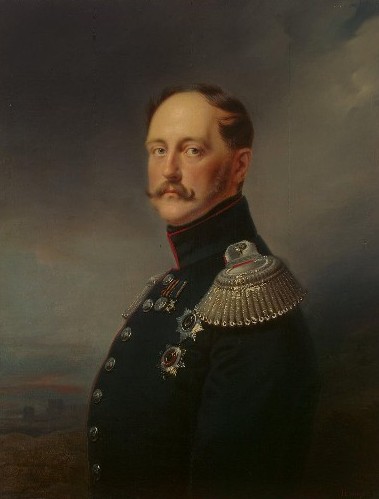Nicholas I
Nicholas I (Nikolai Pavlovich Romanov), b 6 July 1796 in Tsarskoe Selo (now Pushkin), Saint Petersburg gubernia, d 2 March 1855 in Saint Petersburg. (Portrait: Nicholas I.) Russian emperor from 1825. Nicholas ruled as a consistently reactionary anti-Enlightenment and anti-Western autocrat. He suppressed all revolutionary manifestations (eg, the Decembrist movement), centralized the bureaucracy, introduced a secret police (the Third Section) and gendarmerie, and imposed strict censorship throughout the Russian Empire. Externally, his regime supported the status quo in Europe and participated in the suppression of the Polish Insurrection of 1830–1 and the Hungarian Revolution of 1848–9 (see Revolution of 1848–9 in the Habsburg monarchy). Its policies vis-à-vis Ukraine (exemplified in the person of Governor-general Dimitrii Bibikov) were aimed at the obliteration of Ukrainian national particularities, rights, and traditions. Magdeburg law in Kyiv and the Lithuanian Statute were abolished, the Uniate church in Right-Bank Ukraine was forcibly liquidated, Russification was intensified, and a full-fledged struggle was waged against any organized national-political activity (eg, the suppression of the Cyril and Methodius Brotherhood and the exile of Taras Shevchenko). Ukraine's indigenous economic growth (especially in the sugar industry) and the penetration of Ukrainians into the large cities were hindered by a policy of intensive Russian colonization. Nicholas's curtailment of the influence of the Polish landed gentry in Right-Bank Ukraine did not attenuate the plight and oppression of the enserfed Ukrainian peasantry, and peasant unrest erupted in the 1840s and 1850s (eg, the peasant rebellions led by Ustym Karmaliuk in 1830–5 and the rebellion of the Kyiv Cossacks in 1855). The only positive developments in Ukraine during Nicholas's rule were in belles lettres (eg, by Nikolai Gogol and Shevchenko) and higher education and scholarship (eg, the establishment of Saint Vladimir University, the Kyiv Central Archive of Old Documents, the Kyiv Archeographic Commission, the Odesa Society of History and Antiquities, and the Nizhyn Lyceum), but even they were undermined by his rigid policies. The defeat of the Russian Empire in the Crimean War exposed the social, economic, and moral bankruptcy of Nicholas's rule.
BIBLIOGRAPHY
Presniakov, A. Apogei samoderzhaviia: Nikolai I (Leningrad 1925); English trans pub as Emperor Nicholas I of Russia: The Apogee of Autocracy, 1825–1855, ed J. Zacek (Gulf Breeze, Fla 1974)
Lencyk, W. The Eastern Catholic Church and Czar Nicholas I (Rome–New York 1968)
Lincoln, W. Nicholas I: Emperor and Autocrat of All the Russias (Bloomington, Ind–London 1978)
Oleksander Ohloblyn
[This article originally appeared in the Encyclopedia of Ukraine, vol. 3 (1993).]
.jpg)

